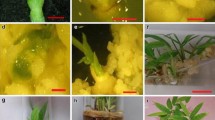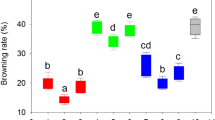Abstract
The development of tissue-culture systems in duckweed has been limited to species of the genus Lemna. Here we report on a tissue-culture system (callus induction, callus growth and plant regeneration) for the rootless duckweed Wolffia arrhiza. We developed a two-step procedure for callus induction in Wolffia using Schenk & Hildebrandt (SH) medium containing glucose, mannitol and sorbitol. In the first stage, explants were precultivated in the presence of 5.0 mg l−1 2,4-dichlorophenoxyacetic acid and 0.5 mg l−1 N6-benzyladenine (BA) for 16 weeks. In the second stage, BA was replaced with 12.5 mg l−1 Picloram (PCL) for 4 weeks. The resulting callus could be maintained in vitro for a long time (about 1 year) with a relatively low concentration of PCL (4.0 mg l−1), or used to regenerate whole plants by transferring it to growth regulator-free SH medium. The protocols created for callus induction and regeneration were highly efficient at each stage (with the efficiency of 97 % for callus formation and 78 % for regeneration).





Similar content being viewed by others
Abbreviations
- 2,4-D:
-
2,4-dichlorophenoxyacetic acid
- BA:
-
N6-benzyladenine
- Dicamba:
-
3,6-dichloro-2-methoxybenzoic acid
- PCL (Picloram):
-
4-amino-3,5,6-trichloropicolinic acid
- TDZ (thidiazuron):
-
1-phenyl-3-(1,2,3-thiadiazol-5-yl) urea
References
Aitken-Christie J, Singh AP, Davis H (1988) Multiplication of meristematic tissue: a new tissue culture system for radiata pine. In: Hanover JW, Keathley DE (eds) Genetic manipulation of woody plants. Plenum Press, New York, pp 413–432
Altpeter F, Xu J, Ahmed S (2000) Generation of large numbers of independently transformed fertile perennial ryegrass (Lolium perenne L.) plants of forage- and turf-type cultivars. Mol Breed 6:519–528
Bailey NTJ (1967) The mathematical approach to biology and medicine. John Wiley and Sons, London, New York, Sydney, pp 36–83
Barro F, Martin A, Lazzeri PA, Barcelo P (1999) Medium optimisation for efficient somatic embryogenesis and plant regeneration from immature inflorescences and immature scutella of elite cultivars of wheat, barley and tritordeum. Euphytica 108:161–167
Boehm R, Kruse C, Veste D, Barth S, Schnabl H (2001) A transient transformation system for duckweed Wolffia columbiana using agrobacterium-mediated gene transfer. J Appl Bot 75:107–111
Bregitzer P (1992) Plant regeneration and callus type in barley: effect of genotype and culture medium. Crop Sci 32:1108–1112
Brettschneider R, Becker D, Lorz H (1997) Efficient transformation of scutellar tissue of immature maize embryos. Theor Appl Genet 94:737–748
Carmi T, Ziv M, Altman A (1997) Bud regeneration growth and proliferation of aspen (Populus tremula) roots in liquid cultures. Acta Hort 447:669–670
Caswel KL, Leung NL, Chibbar RN (2000) An efficient method for in vitro regeneration from immature inflorescence explants of Canadian wheat cultivars. Plant Cell Tiss Org Cult 60:69–73
Chang WC, Chiu PL (1976) Induction of callus from fronds of duckweed (Lemna gibba L.). Bot Bull Acad Sinica 17:106–109
Chang WC, Chiu PL (1978) Regeneration of Lemna gibba G3 through callus culture. Zeitschriftfschriftfür Pflanzenph 89:91–94
Dahleen LS, Bregitzer P (2002) An improved media system for high regeneration rates from barley immature embryo-derived callus cultures of commercial cultivars. Crop Sci 42:934–938
Decock PC, Cheshire MV, Mundie CM, Inkson RHE (1979) The effect of galactose on the growth of lemna. New Phytol 82:679–685
Eapen S, George L (1990) Influence of phytohormones, carbohydrates, amino acids, growth supplements and antibiotics on somatic embryogenesis and plant differentiation in finger millet. Plant Cell Tiss Org Cult 22:87–93
Edelman M, Perl A, Flaishman M, Blumenthal A (1998) Transgenic Lemnaceae. Australian Patent Publication AU759570C
Escobedo-GraciaMedrano RM, Maldonado-Borges JI, Burgos-Tan MJ, Valadez-Gonzales N, Ku-Cauich JR (2014) Using flow cytometry and cytological analyses to assess the genetic stability of somatic embryo-derived plantlets from embryogenic Musa acuminate Colla (AA) ssp. malaccensis cell suspension cultures. Plant Cell Tiss Org Cult 116:175–185
Fernandez S, Michaux-Ferriere N, Coumans M (1999) The embryogenic response of immature embryo culture of durum wheat (Triticum durum Desf.): histology and improvement by AgNO3. Plant Growth Regul 28:147–155
Filippov M, Miroshnichenko D, Vernikovskaya D, Dolgov S (2006) The effect of auxins, time exposure to auxin and genotypes on somatic embryogenesis from mature embryos of wheat. Plant Cell Tiss Org Cult 84:192–201
Frick H (1991) Callogenesis and carbohydrate utilization in Lemna minor. J Plant Phyziol 137:397–401
Friedrich AS (2005) Transformation und Fermentation von Wolffia spec. Untersuchungenzu Kultivierung Dissertation 177 pp
Gasdaska JR, Spenser D, Dickey L (2003) Advantages of therapeutic protein production in the aquatic plant lemna. Bio Process J 2:49–56
Halperin W (1967) Population density effects in embryogenesis in carrot cell cultures. Expt Cell Res 48:173–179
Ilan A, Ziv M, Halevy AA (1995) In vitro propagation in liquid culture and acclimatization of Brodiaea. Scientia Hort 63:101–112
Jacobsen J, Matthews P, Abbott D, Wang M-B, Waterhouse P, Buza L, Thornton S, Gubler F (1999) Barley transformation breeding: further progress and remaining problems. Proceedings of the 9th Australian Barley Technical Symposium, pp. 18–19
Jiang W, Cho MJ, Lemaux PG (1998) Improved callus quality and prolonged regenerability in model and recalcitrant barley (Hordeum vulgare L.) cultivars. Plant Biotechnol 15:323–346
Krikorian AD, Kann RP (1981) Plantlet production from morphogenetically competent cell suspension of daylily. Ann Bot 47:679–686
Kruse C, Boehm R, Veste D, Barth S, Schnabl H (2001) Transient transformation of Wolffia columbiana by particle bombardment. Aquat Bot 72:175–181
Lemaux PG, Cho MJ, Zhang S, Bregitzer P (1998) Transgenic cereals: Hordeum vulgare L. (barley). In: Vasiled IK Molecular improvement of cereal crops, Kluwer Academic Publishers, Dordrecht, Netherlands, pp 255–316
Les DH, Crawford DJ, Landolt E, Gabel JD, Kimball RT (2002) Phylogeny and systematics of Lemnaceae, the duckweed family. System Bot 27:221–240
Li J, Jain M, Vunsh R, Vishnevetsky J, Hanania U, Flaishman M, Perl A, Edelman M (2004) Callus induction and regeneration in Spirodela and Lemna. Plant Cell Rep 22:457–464
Luhrs R, Lorz H (1987) Plant regeneration in vitro from embryogenic cultures of spring- and winter-type barley, Hordeum vulgare L. Theor Appl Genet 75:16–25
McCown BH, Zeldin EL, Pinkalla HA, Dedolph RR (1988) Nodule culture: a developmental pathway with high potential for regeneration, automated propagation and plant metabolite production of woody plants. In: Hanover MW, Keathley DE (eds) Genetic manipulation of woody plants. Plenum Press, New York, pp 146–166
Moon HK, Stomp AM (1997) Effect of medium components and light on callus induction, growth and frond regeneration in Lemna gibba (duckweed) in vitro. Cell Dev Biol 33:20–25
Moon HK, Rajbhandari N, Stomp AM (1998) Effect of media components and phytohormones on in vitro frond proliferation of Lemna gibba G3 and 24 additional L. gibba strains. Plant Res 1:98–104
Morel G (1974) Clonal multiplication of orchids. In: Withner CL (ed) The orchids: scientific studies. Wiley, New York, pp 169–222
Nhut DT, Le BV, Van KTT (2000) Somatic embryogenesis and direct shoot regeneration of rice (Oryza sativa L.) using thin cell layer culture of apical meristematic tissue. J Plant Physiol 157:559–565
Oldach KH, Morgenstern A, Rother S, Girgi M, O’Kennedy MM, Lorz H (2001) Efficient in vitro plant regeneration from immature zygotic embryos of pearl millet [Pennisetum glaucum (L.) R. Br.] and Sorghum bicolor (L.) Moench. Plant Cell Rep 20:416–421
Ly Thu PT, Anh NH, Huong PT, Hoa NT, Ham LH (2010) Improvement of transformation procedure into duckweed (Wolffia sp.) via Agrobacterium tumefaciens. Tạpchí Côngnghệ Sinhhọc8(1) http://www.vap.ac.vn/index.php?option=com_content&view=article&id=160:hoan-thin-quy-trinh-chuyn-gen-vao-beo-tm-wolffia-thong-qua-vi-khun-agrobacterium-tumefaciens&catid=64:vol-8-no-1-2010&Itemid=90
Plaza-Wüthrich S, Tadele Z (2012) Millet improvement through regeneration and transformation. Biotechnol Mol Biol Rev 7:48–61
Rival S, Wisniewski JP, Langlais A, Kaplan H, Freyssinet G, Vancanneyt G, Vunsh R, Perl A, Edelman M (2008) Spirodela (duckweed) as an alternative production system for pharmaceuticals: a case study, aprotinin. Transgenic Res 17:503–513
Schenk RU, Hildebrandt AC (1972) Medium and techniques for induction and growth of monocotyledonous and dicotyledonous plant cell cultures. Can J Bot 50:199–204
Sharma VK, Hansch R, Mendel RR, Schulze J (2005a) Seasonal effect on tissue culture response and plant regeneration frequency from non-bombarded and bombarded immature scutella of barley (Hordeum vulgare) harvested from controlled environment. Plant Cell Tiss Org Cult 81:19–26
Sharma VK, Hansch R, Mendel RR, Schulze J (2005b) Mature embryo axis-based high frequency somatic embryogenesis and plant regeneration from multiple cultivars of barley (Hordeum vulgare L.). J Exp Bot 56:1913–1922
Spencer D, Lynn D, Gasdaska J, Wang X, Cox K, Peele C (2005) Expression of plasminogen and microplasminogen in duckweed. US Patent 2005262592 (A1)
Stefaniak B, Wozny A, Budna I (2002) Callus induction and plant regeneration in Lemna minor L. Biol Planta 45:469–472
Stomp AM, Rajbhandari N (2000) Genetically engineered duckweed. US Patent 6,040,498
Tubic L, Anacˇkov G, Milojevic´ J, Ghalawenji N, Mitic´ N, Igic´ R, Tubic S (2014) High variability in the tissue culture response of root-tips of Allium ascalonicum individuals and optimization of the regeneration procedure. Plant Cell Tiss Org Cult 118:101–110
Vunsh R, Li J, Hanania U, Edelman M, Flaishman M, Perl A, Wisniewski JP, Freyssinet G (2007) High expression of transgene protein in Spirodela. Plant Cell Rep 26:1511–1519
Yamamoto YT, Rajbhandari N, Lin XH, Bergmann BA, Nishimura Y, Stomp AM (2001) Genetic transformation of duckweed Lemna gibba and Lemna minor. In Vitro Cell Dev Biol Plant 37:349–353
Ziv M (1989) Enhanced shoot and cormlet proliferation in liquid cultured gladiolus buds by growth retardants. Plant Cell Tiss Org Cult 17:101–110
Ziv M (1990) The effect of growth retardants on shoot proliferation and morphogenesis in liquid cultured gladiolus plants. Acta Hort 280:207–214
Ziv M (1999) Bioreactor technology for plant micropropagation. Hortic Rev 24:1–30
Ziv M, Ariel T (1991) Bud proliferation and plant regeneration in liquid-cultured philodendron treated with ancymidol and paclobutrazol. J Plant Growth Regul 10:53–57
Ziv M, Hadar A (1991) Morphogenic pattern of Nephrolepsis exaltata Bostoniensis in agar-gelled or liquid culture. Implication for mass propagation. Israel J Bot 40:7–16
Ziv M, Lilien-Kipnis H (1997) Bud cluster proliferation and bulb formation from bioreactor cultures of Ornithogalum dubium. Acta Hort 430:307–310
Ziv M, Shemesh D (1996) Propagation and tuberization of potato bud clusters from bioreactor culture. In vitro Cell Dev Biol Plant 32:31–36
Ziv M, Kahany S, Lilien-Kipnis H (1994) Scaled-up proliferation and regeneration of Nerine in liquid cultures. Part I. The induction and maintenance of proliferating meristematic clusters by paclobutrazol in bioreactors. Plant Cell Tiss Org Cult 39:111–117
Ziv M, Ronen G, Raviv M (1998) Proliferation of meristematic clusters in disposable presterilized plastic bioreactors for large-scale micropropagation of plants. In vitro Cell Dev Biol Plant 34:152–158
Author information
Authors and Affiliations
Corresponding author
Additional information
Callus induction and regeneration cell-culture cycle for Wolffia arrhiza has been created for the first time in the world, which is characterized by high efficiency at each stage.
Rights and permissions
About this article
Cite this article
Khvatkov, P., Chernobrovkina, M., Okuneva, A. et al. Callus induction and regeneration in Wolffia arrhiza (L.) Horkel ex Wimm . Plant Cell Tiss Organ Cult 120, 263–273 (2015). https://doi.org/10.1007/s11240-014-0603-4
Received:
Accepted:
Published:
Issue Date:
DOI: https://doi.org/10.1007/s11240-014-0603-4




